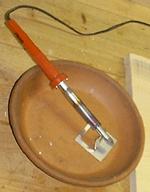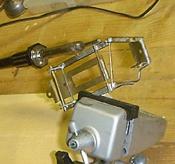| The Soldering Phenomenon
by Jim Allen, Aug. 25, 2002
It was a peculiar historical coincidence that in 1965, so many young men knew how to solder. This
unusual circumstance made possible the scratchbuilding of brass slot car chassis, and
underpinned the explosive growth of the sport of slot car racing.
The men who scratchbuilt slot car chassis, and we are talking mostly men (and boys) here,
had learned how to solder for a number of different reasons, few of which would be true today.
 Consider perhaps the largest group, those who learned to solder electronic parts. Electronic
parts were large enough in those days to solder by hand. Circuit boards were hand-soldered
with resistors over 1/2 inch long. Transistors were 3/8 inch silver top hats, with three
wire legs looking like War of the Worlds tripod aliens. Disk and mylar capacitors, diodes,
switches and coils, all were as large as aspirin pills, and were soldered one wire at a time to a circuit board.
Today these parts are microscopic, a million on a pinhead, and are destroyed by the heat
of a soldering iron! Almost no one hand-solders electronic parts today. Consider perhaps the largest group, those who learned to solder electronic parts. Electronic
parts were large enough in those days to solder by hand. Circuit boards were hand-soldered
with resistors over 1/2 inch long. Transistors were 3/8 inch silver top hats, with three
wire legs looking like War of the Worlds tripod aliens. Disk and mylar capacitors, diodes,
switches and coils, all were as large as aspirin pills, and were soldered one wire at a time to a circuit board.
Today these parts are microscopic, a million on a pinhead, and are destroyed by the heat
of a soldering iron! Almost no one hand-solders electronic parts today.
Perhaps the next largest group of solderers in 1965 were the model train scratchbuilders.
Model train fanatics constructed their own engines from thin brass sheets and brass wire,
expertly soldered together, sanded smooth and painted black. They also soldered the rails together,
and all the wiring and lights were soldered. But most of these model train
craftsmen are gone, and today, a model railroad hobbyist can buy super-detailed plastic engines and cars,
better than almost every handmade example. Almost no one does it with solder anymore.
In addition to the two groups above, there were the ham radio and amateur radio buffs, many of whom
built their own equipment, or at least, repaired it, by hand soldering. There are also the
plumbers, more used to working with a blow torch and copper, but whose skills in soldering
crossed over perfectly. Finally, soldering was widespread among
artists and craftsmen, who soldered tin, steel, copper and brass while hand-making buckets,
rain gutters, scoops and other utensils, and modern art. But the ham radio operators and
handcraft artisans are almost all gone.
 Here is my own soldering story: My dad learned to solder in the Navy. He was stationed in
Hawaii at the transmitter shack, where he learned to solder electronic radar and radio parts.
After the Korean War, Dad soldered more as he dabbled in amateur radio and model railroading.
He worked in the hardware section of IBM for his first ten years there, and again was called
upon to solder electronic parts. Here is my own soldering story: My dad learned to solder in the Navy. He was stationed in
Hawaii at the transmitter shack, where he learned to solder electronic radar and radio parts.
After the Korean War, Dad soldered more as he dabbled in amateur radio and model railroading.
He worked in the hardware section of IBM for his first ten years there, and again was called
upon to solder electronic parts.
Dad ordered and built a Knight-Kit receiver when I was 5 years old. When I was growing up,
he sent for and built two Heathkit TVs, both of which worked
perfectly the first time they were turned on! I learned to solder during the building of these kits. He
allowed me to solder hundreds of joints in these TVs. We also built several of the Radio Shack
electronic kits (crystal radio and the 7 push-button "organ"), and a Heathkit metal detector.
Thus, when I proceeded to solder together the brass rods and pans of a slot car chassis,
I already knew what to do, and had the skills to do it. But little of my story would apply to any
young boy today, who slumps on the couch in front of the TV (which machines soldered), pushing
buttons on his electronic GameBoy (which machines soldered), listening to his Walkman (which... you get the idea!)
 In conclusion, I'd like to make the claim that what happened in 1965, the explosion of
basement slot car chassis scratchbuilders, could not happen today. There is not a critical mass
of young men with pre-existing soldering skills. It follows that the sport will not again experience the
widespread experimentation and synergistic confluence of ideas that led to the rapid chassis
development seen from 1965 to 1972. Not only are most of the best ideas already known, and
the bad ideas already weeded out, but there are many fewer people available to
solder together the serendipitous good ideas that do arise. In conclusion, I'd like to make the claim that what happened in 1965, the explosion of
basement slot car chassis scratchbuilders, could not happen today. There is not a critical mass
of young men with pre-existing soldering skills. It follows that the sport will not again experience the
widespread experimentation and synergistic confluence of ideas that led to the rapid chassis
development seen from 1965 to 1972. Not only are most of the best ideas already known, and
the bad ideas already weeded out, but there are many fewer people available to
solder together the serendipitous good ideas that do arise.
Please look to our
Message Board
to make comments, or read what others have to say. Thanks! |